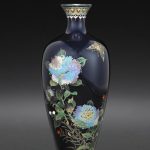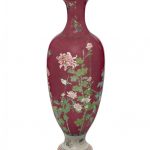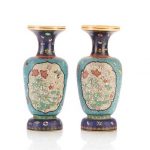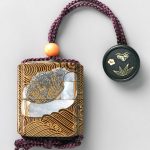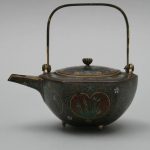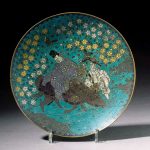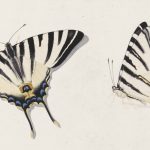Japanese cloisonne. Cloisonné enamels in Japan had traditionally been used only as small areas of decoration on architecture and on sword fittings. Around 1833 a former samurai, Kaji Tsunekichi of Nagoya in Owari Province (modern Aichi Prefecture), like many other samurai of that time, was forced to find ways to supplement his meagre official income. It is believed that Kaji obtained a piece of Chinese cloisonné enamel and took it apart, examined how it was made and eventually produced a small cloisonné enamel dish.
By the late 1850s he had taken on pupils and was appointed official maker to the regional warlord of Owari province. There was a huge increase in the production of cloisonné enamel ware following the ‘reopening’ of Japan in the 1850s and the ensuing obsession in the West for all forms of Japanese art. Reference: The Victoria and Albert Museum
A small cloisonné enamel vase By Hayashi Kodenji, late 19th/early 20th century Of baluster form and worked in gilt and silver wire with a multicolor enamel design of a butterfly hovering above flowering hydrangea and wild pinks silhouetted against a mirror black ground, the neck and foot encircled by bands of jeweled lappets, with silver rims, the base with the company mark. 4 7/8in (12.4cm) high
Sold for US$ 11,250 (£ 8,647) inc. premium at Bonhams in 2014
Vase. Birds, flowers and insects. Cloisonné wireless enamelling. Marked. Made by: Namikawa Sosuke Circa 1897
p>Reference: © The Trustees of the British MuseumA cloisonné enamel hexagonal vase Meiji period (late 19th century), signed Kyoto Namikawa (workshop of Namikawa Yasuyuki; 1845-1927) The tall, tapering hexagonal vase with high shoulders decorated in polychrome enamels and thick and thin gold wires with two butterflies flying above trailing branches of luxuriant wisteria, the flowers and leaves finely detailed, all against a dark blue ground, rims and base silver, signature incised on base 12¼in. (31.1cm.) high
Sold for USD 225,750 at Christies in 2013
Japanese Cloisonne Vase Taisho Period Of tall slender shape the rose colored ground with butterflies flying amid blossoming chrysanthemum between floral sprays and diaper bordering. Height 35 1/2 inches.
Sold for $812 (includes buyer’s premium) at Doyle New York in 2019
PAIR OF JAPANESE TOTAI CLOISONNE PORCELAIN VASES
On Satsuma body painted with butterflies to top, body wired with turquoise ground floral and butterfly patterns. Base signed Kinkozan in red. Meiji period, 19th C. H. 24cm (9 1/2 in.)Conditions to top.
Sold for CA$650 at A.H. Wilkens Auctions & Appraisals in 2019
Miniature Inrō with Design of Firewood-laden Boats on Waves,19th century Shibata Zeshin The small boats that plied the misty waters of the Uji River often appear in Japanese classical literature as images of rusticity and human vulnerability. They are a potent and recurring motif in the later chapters of the Tale of Genji. This miniature is copied from a design by the Rimpa artist Kōetsu, who took such unmistakable literary references and distilled them into striking forms.
Reference: The Metropolitan Museum of Art
Japanese cloisonne teapot Made in Japan, 1900-1950. Squat hexagonal cloisonne teapot with a tripod base. The body of the teapot has six angular sides and a flat top with a lid which slots into the mouth, a short horizontal spout and a square shaped handle. The exterior of the teapot comprises a black background with intricate gold detail decoration and six heart-like shapes containing floral arrangements. Around the base of the pot is a band of long, elongated petal-shapes in blue, turquoise and green and there is a stylised floral band also around the outside edge of the mouth. On top of the lid are two butterflies, gold circular decoration and an ornate blue, green, pink and cream border. The interior of the teapot is blue glazed and undecorated with two gouge marks on the inside base and wall and on the centre of the exterior of the base is a small red flower.
Reference: Museum of Applied Art and Sciences
A cloisonné dish Edo period the interior decorated with a samurai sitting on a horse drinking water, an attendant nearby below flowering branches and butterflies, the exterior decorated with insects and a frog reserved on a diaper ground diam 28cm
Sold for 1,800 EUR at Sothebys in 2006
Cloisonne enamel vase decorated with butterflies. The body of the vase is copper with an applied silver rim and a silver-gilt inner neck ring.
The copper body of the vase has an applied silver rim, a silver-gilt inner neck-ring and a silver base plate, the interior of which is also silver-gilt. The pale grey enamel ground is decorated with a silver yusen design of exotic butterflies. The butterflies’ bodies have been skillfully delineated with different thicknesses of silver yusen and areas of shosen. The polychrome enamels of the wings have been applied in extraordinarily fine detail and there are two small ‘eyes’ in chakinseki on the upper butterfly. The inner base plate is silver-gilt and carries the engraved four-character mark Aichi Hayashi Ko[denji] within a circular area.
Reference: © Victoria and Albert Museum
